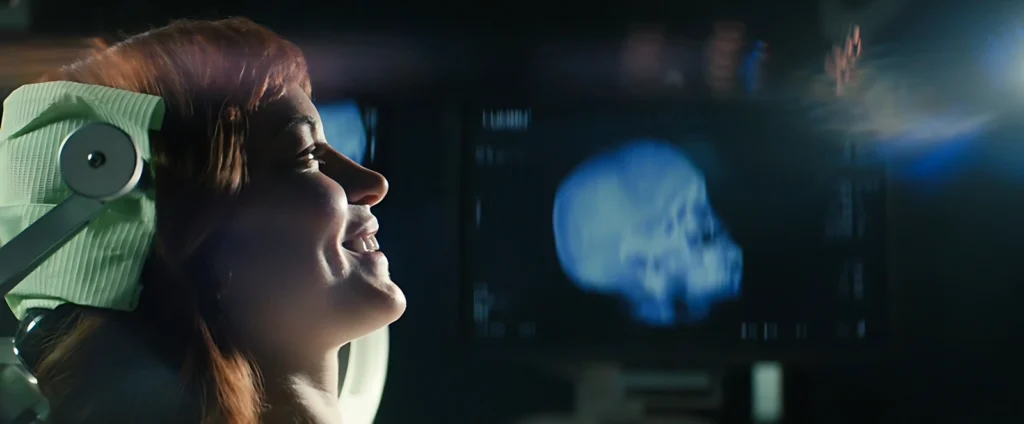In Severance, the Apple TV+ series that literally splits the self between work and personal life, few characters are as intriguing—and unsettling—as Helena Eagan. Heiress to the Lumon empire and a volunteer in the controversial severance experiment, she enters the story as a key figure in the corporate elite… but Helena Eagan’s motivation soon reveals a moral dilemma far deeper than it first appears.
At first glance, Helena seems to represent the oppressive power. She not only accepts the severance procedure—she promotes it, stages it, exploits it. Yet as we discover the layers unfolding between her “outie” persona (Helena) and her “innie” counterpart (Helly R.), something far more complex emerges. What begins as a marketing stunt transforms into an internal battle, where true identity becomes harder and harder to define.
This article goes far beyond what the show reveals on the surface. We’ve gathered essential scenes, striking quotes, and behind-the-scenes insights to trace a full profile of Helena Eagan—her choices, her masks, and her breaking points. Is she a villain, a victim, or both? And what does her personal collapse reveal about the modern dystopias of work, identity, and obedience?
The answer may lie precisely where she least expected: within herself.
Who Is Helena Eagan?

Daughter of Lumon Industries CEO Jame Eagan and direct descendant of the company’s near-mythical founder, Kier Eagan, Helena was raised from childhood to carry on the corporation’s legacy. Rather than question the family doctrines, she fully embraced them. She believed the severance technology—which splits a worker’s memories between on-duty and off-duty life—was not only ethical but essential for a better future. And to prove it to the world, she chose to undergo the procedure herself.
Thus, her “innie” was born: Helly R., hired to work in Lumon’s data refinement department.
Unlike other severed characters like Mark or Dylan, Helena wasn’t trying to escape pain, boredom, or guilt. Helena Eagan’s motivation was entirely strategic: she wanted to be the public face of the experiment, the living proof that Severance was safe, humane, and beneficial. Her plan was to stage a journey of personal growth within the company and then reveal herself as the CEO’s daughter — sealing a narrative of trust and personal sacrifice.
But what Helena didn’t predict was that her “inner half,” created to simply endure the work routine, would evolve into a consciousness of its own. And unlike the promotional script, Helly R. responded with revolt, despair, and a visceral rejection of captivity.
That collapse between intention and consequence marked the beginning of Helena’s downfall—and the unraveling of how she saw herself.
The Split That Didn’t Work: Helena vs. Helly

A Corporate Theory That Failed in Practice
In Lumon’s pitch, severance is a liberation: the inner self works without remembering the outside, and the outer self lives free from work stress. But in Helena Eagan’s case, this division proved illusory—and even dangerous.
The Birth of Rebellion: Helly R. Awakens
Her innie, named Helly R., immediately distrusts the system. From her first moments inside the company, she tests boundaries, tries to escape, hides notes, and even attempts suicide to flee the corporate prison. Helly’s visceral rejection is no mere glitch—it’s an act of insurgency against her own creator.
This rupture between intention and outcome calls Helena Eagan’s motivation into question: what began as a strategic performance turns into a real conflict between two opposing consciousnesses.
Helena’s Cruel Response

And Helena responds to this rebellion with coldness. In a striking scene from season one, the outie is confronted by her innie: “Why are you doing this to me?” Her answer is cutting:
“I’m a person. You are not.”
This line marks one of the series’ most brutal—and revealing—moments. Helena doesn’t view Helly as a legitimate consciousness. To her, the working part isn’t a someone, but a tool. An instrument for a greater good.
The Unexpected: When the Tool Becomes a Person
But what she never expected was for that tool to feel, think, resist—and become more real than herself.
Severance, in this case, didn’t fail — or rather, it succeeded so well that it created a new person, with memories, desires, and a will of her own. Helly isn’t just an “operating mode” of Helena. She’s a separate identity, formed precisely in response to captivity — and one that exposes the failure in Helena Eagan’s motivation.
The Awareness Helena Didn’t Want to Face
And that forces Helena, against her will, to confront the humanity she tried to amputate from herself.
The show never romanticizes this relationship. Helly doesn’t “convince” Helena to change. On the contrary: Helena bends under the weight of her own choices as the truth emerges through the part she thought she could control.
The Core Dilemma in One Line
And this is where the most unsettling point of her arc begins:
when your “bad side” refuses to obey—and proves to be better than you.
The Plan, the Disguise, and the Broken Illusion
When Shame Doesn’t Lead to Redemption
After her public image collapses at the end of season one, Helena Eagan could have stepped back. But she didn’t. Instead, she doubled down: she decided to return to the severed floor to control the narrative from within. With that, Helena Eagan’s motivation remains intact: to keep the experiment alive at any cost.
Only this time, she wasn’t a passive observer of her innie. Helena made a bold move: she entered the severed floor as herself—pretending to be Helly R.—and blocked the innie’s access to consciousness.
It was a new experiment: a full disguise where the outie posed as the innie to sabotage any rebellion and regain the company’s trust.
Helena’s Performance as Helly

In the early episodes of season two, Helena acts reserved, but clearly disconnected. Her colleagues notice something’s off: she’s colder, awkward, and forgetful of key events.
Irving, in particular, grows suspicious. He senses that something isn’t right—Helly R. seems to have forgotten how to connect, as if she were… someone else.
And he’s right.
The Drowning Attempt and the Collapse of the Disguise

During a ritual ceremony at Woe’s Hollow, Irving gives in to impulse and tries to drown Helena in a tank, believing that pushing her to the edge will expose her true identity.
In the middle of the drowning, the outie’s control is disrupted. The real Helly R.—the innie—returns to consciousness. She wakes up, confused, with Irving trying to drown her.
Stunned, he immediately stops. He realizes that now it’s truly Helly, and apologizes:
“I’m sorry… I thought you were her.”
The Consequences: Exposure and Shame
Helena’s cover is blown. Seth Milchick steps in, disables the override, and the innie regains full control.
Irving is fired from Lumon.
And Helena, for the first time, is forced to face the fact that she can no longer control the narrative—or herself.
Read more: The Revelation of Helena Eagan in Severance and Its Impact
The Father, the Cult, and Rejection: Jame Eagan as the Cruel Patriarch Archetype
More Than Just a CEO Figure

Jame Eagan’s presence in Severance is deeply symbolic. As the direct heir to Kier Eagan and current Lumon CEO, he represents the continuation of a corporate cult with near-religious ambitions. His authority is absolute, his charisma nonexistent—and his obsession with maintaining doctrine makes him truly dangerous.
But it’s on a personal level that this power turns most destructive.
The Affectionless Upbringing of a Daughter Molded to Serve

Helena was molded from childhood to serve the company. In interviews, Britt Lower notes that her character was raised in a cold environment, without maternal figures, and with a father who offered only conditional approval. Everything she knew came from Lumon.
And all she wanted was to be worthy of it.
Explicit Disdain and Dehumanization

In the final episodes of season two, Jame Eagan confronts Helly R.—fully aware he’s speaking to the innie—and declares without hesitation:
“I do not love my daughter.”
Helly responds with biting irony:
“You sound like a great dad.”
The line is not just an insult—it marks the definitive break. Jame doesn’t value Helena for who she is, but for how well she serves Kier’s vision. And if she fails, he discards her.
The Ideal Successor Is Not His Daughter—But the Innie
Later, Jame reveals the height of cruelty: he only saw Kier’s spirit in someone after meeting Helly R.
“I saw Kier in her. Not in my daughter.”
In other words: the consciousness Helena created to be controllable, docile, and disposable is, to her father, more valuable than Helena herself.
That moment perfectly defines Lumon’s philosophy: blood doesn’t matter. Loyalty doesn’t matter. Only usefulness does.
Interpretations: Why Helena Might Be the Most Human Character in the Series
The Most Inhumane… and the Most Human
At first glance, calling Helena Eagan the most human character in Severance may seem contradictory. But that’s precisely what makes her fascinating.
She tried to live without ethics, empathy, or doubt. And she failed.
The Pain of Watching Her Own Humanity Slip Away
Unlike the other outies, Helena had access to her innie’s recordings. And that shook her.
In a seemingly casual yet revealing moment, she confesses to Mark:
“I didn’t like who I was on the outside. I was ashamed.”
Spoken while still pretending to be Helly, the line carries much more weight. She’s talking about herself—and everything she tried to bury.
More Than an Antagonist: A Shattered Mirror of the Viewer
Helena shows what happens when we try to amputate parts of ourselves to fit into broken systems.
She tried to be perfect—for her father, for Lumon, for the “greater good.” And in doing so, she became incapable of taking pride in her own life.
If there is anything deeply human in Severance, it is this inner failure:
realizing we’ve become what we feared most.
Conclusion: What Can We Expect from Helena Eagan?

A Character in Freefall—Or in Transition?
Helena is shattered. She moves no one. She has no allies. Yet she still carries the Eagan legacy—and that alone may make her the most dangerous piece on the board.
She May Rebel—But Not for Noble Reasons
If she switches sides, it won’t be for heroism. It will be out of shame, guilt, or the pain of belonging neither to the elite that shaped her nor the consciousness she created.
And that might be even more powerful.
Between two worlds, Helena Eagan’s motivation may still decide the course of the story.
Helena is the only one who truly knows both sides of severance. She saw what she created. And that vision might be what it takes to bring everything down—or rebuild it from the ashes.
If the series follows its instincts, Helena won’t be redeemed.
But she might be forced to reinvent herself, with nowhere left to return.
She may not be the liberator.
But she could be the spark that collapses a cult rooted in her own house.
Explore more Severance secrets on our thematic page
Posts Recomendados
Carregando recomendações...



